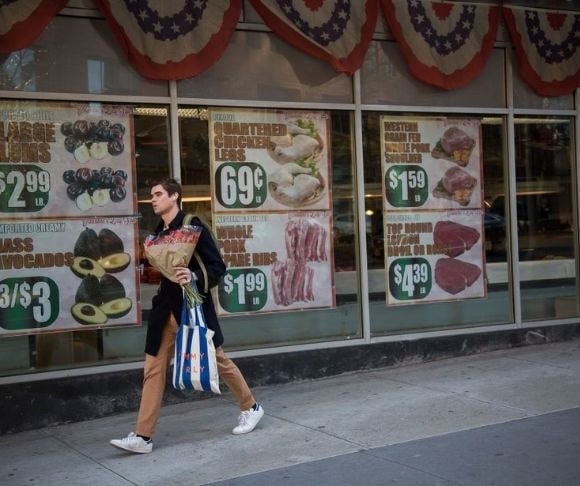The Federal Reserve has struggled to get inflation under control. While the consumer price index (CPI) has declined for the last several months, the monetary phenomenon – as Milton Friedman called it – is still pronounced in multiple sectors of the economy, from food to services. And, according to Minneapolis Fed Bank President Neel Kashkari, the American people better get used to it for another couple of years. So does this mean it is time to increase the arbitrary inflation target rate?
Federal Reserve Is Committed
Sixteen months ago, the Federal Reserve insisted that inflation was transitory. In fact, two years ago, the US central bank believed that inflation would be nonexistent, despite all the evidence before its eyes. Today, the Fed may not realize its goal of bringing inflation back to its 2% target rate until 2025.
Speaking in an interview with CNBC’s Squawk Box, Kashkari presented the case that the Eccles Building needs to raise the benchmark fed funds rate (FFR) more aggressively and then allow monetary policy to work its way through the national economy. Ultimately, the Minneapolis Fed head noted, the central bank needs to let inflation guide the Federal Open Market Committee (FOMC) policy decisions rather than its models.
“It’s challenging because there are lags that you’re well aware of,” he said. “But the most important thing that people should take away from this is we’re totally committed to getting inflation back down to 2%. Not two and a half, not three, getting back down to 2%. And we’re going to get that done. Now, is it going to take two years? Is it going to take a little longer? I’m not exactly sure, but we’re going to get it done.”
Abandon the 2% Target?
Central banks have been keen on adopting a targeted inflation model. For the last three decades, central banks worldwide have introduced an inflation target, following the lead of the Reserve Bank of New Zealand in 1990, which maintained a goal of 1% to 3%. This was followed by Canada (1991), the United Kingdom (1992), Australia (1993), and Sweden (1993). Since then, dozens of others have established an ideal rate, including the United States in 2012.
But is the 2% target rate a random figure? Fed Chair Jerome Powell all but conceded that it is, arguing at the Economic Club of Washington, DC, earlier this month that the number is an international standard implemented by central banks across the globe. He also has rejected suggestions that the Fed is even considering abandoning the figure and introducing a higher rate. However, Powell’s denial has been a tad too intense, signaling that perhaps this is something insiders have speculated.
That said, the 2% concept may have been influenced by legendary economist Friedman, who opined that an optimal rate would not punish households for holding non-yielding assets but also adapt to economic conditions, adding that it is the law of nature that prices are going to rise 1% or 2% a year. Friedman also asserted that inflation was the consequence of running the printing press, explaining in 1969 that “inflation is always and everywhere a monetary phenomenon, in the sense that it is and can be produced only by a more rapid increase in the quantity of money than in output.”

(Photo by Michael Nagle/Xinhua via Getty Images)
But if inflation stayed above the 2% bull’s-eye, would this weigh heavily on the US economy? In a 2017 letter to the rate-setting committee, economists stated that “there’s no evidence that 3% or 4% inflation does substantial damage relative to 2% inflation.” While a case can be argued that cumulative erosion of Americans’ purchasing power can have long-term ramifications, central banks might face greater scrutiny surrounding their post-pandemic targets.
Although inflation has likely peaked, the latest developments signal ebb-and-flow movements comparable to what occurred in the 1990s. As Liberty Nation recently noted, inflation had soared in the late 1970s and early 1980s, eventually showing that it was exhausted in 1986 when it fell to 1.9%. However, the annual CPI continued to climb between 3.03% and 5.4% in the following years. It was only in the middle of the 1990s that it appeared the inflation threat had been vanquished.
It is understandable why the Fed would refrain from putting the kibosh on 2%, as such a decision would prove that Powell and Co. dropped the ball and failed to achieve its objective. Moreover, how the financial markets react would be challenging to surmise, which may be another reason why the institution has routinely denied having this discussion.
Inflation Is Evil
In the end, whether the CPI or the personal consumption expenditures (PCE) price index is 2% or 12%, inflation is an odious entity that hurts the impecunious and the middle class, contrary to what Keynesians like Paul Krugman have purported for years. The Federal Reserve produces this monster by enabling reckless spending on Capitol Hill and running the printing press to fund the madness in Washington. Friedman routinely sounded the inflation alarm. Still, his influential and seminal work on monetarism contributed to the policy chaos witnessed inside the chambers of central banks everywhere.
Of course, everything could have been resolved by now if the Fed had ended its pandemic-era unlimited quantitative easing (QE) in the spring of 2020 or front-loaded its rate hikes in March 2022. But nobody would be brave enough to champion this prescription in a public policymaking arena of kicking the can down the road.




